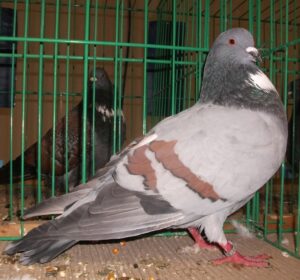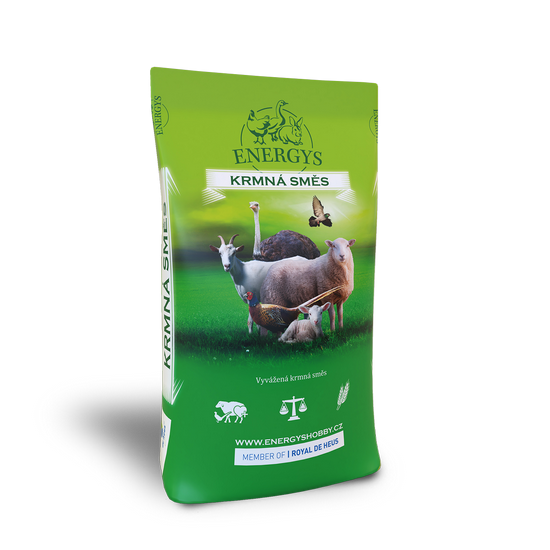Rabbits
Poultry
Laying hens
Quails
Guinea pigs
Pigs
Ostriches
Sheep and goats
Pigeons
Pheasants
Forest animals
BREEDING PIGEONS – PART 1
Breeders organised in the Czech and Slovak breeders associations are currently involved in breeding pigeons. The breeding aims of organised pigeon breeders are very varied, as pigeon breeds are various. There are also differences in the methods for breeding, accommodation, treatment, feeding, for some training and competitions for some utility in the form of meat.
Today, the classic appearance of villages is fading, many city dwellers are moving to the countryside. They only require a little land that, together with a house, does not exceed 500 sqm. If a homeowner wants to breed pigeons, then the only option is in a pigeon coop, because a neighbour that has a plot of land that is just as small and is not fond of pigeons and breeding them would get in touch in short order if the pigeons were sitting on his roof. Obviously, in such space it is not possible to breed poultry, rabbits only as pets. This is because all animals produce excrement, which has to be composted, and there is no room for this in a nice small garden. An aspiring breeder can, at most, create a small space (sometimes inside a building) for breeding Japanese quail.
In the past, pigeons were raised as standard in farmyards. They supplemented the farm animals, but they also livened up the place for farmers, who otherwise had gallinaceous and water poultry. Some pigeons had an interesting way of flying, so they were a pleasure for the eyes. Pigeons were not demanding in terms of treatment and feeding, they found a quantity of feed in the fields around the village. They were mostly pigeons flying to fields to get food, for example the Slovak Cropper, Czech Steller Cropper, Moravian Strasser and others. Numerous seasonal litters mostly decorated the Sunday table of the farmer and his family. Soup was cooked from adult pigeons that were no longer needed, young pigeons were stuffed and served on the table as roasts or cooked in different ways.
Today, pigeons are raised mostly for their appearance and to compete at exhibitions, and breeders, in particular of large breeds, use the meat from individuals unsuitable for further breeding. So this article is for future breeders that have room for pigeons and live a sufficient distance from neighbours that the pigeons could bother.
At the end of the 1980s and in the 1990s, small pigeon farms started to be established here, and there were also larger ones with 1,000 breeding pairs for the purpose of producing meat squabs. I visited one breeding facility close to Nitra at this time. It had excellent facilities and arrangements, under constant veterinary supervision. Sales were based on a contract and the meat was mostly for export. None of the breeding facilities has survived until today. Pigeon meat is currently only consumed in the breeder’s family. Information about the production of pigeon meat is not included in statistical data, because pigeons are not farm animals in Slovakia. Pigeon breeding and slaughtering is also not dealt with by Decree No. 230 Coll. of 23 July 1998 on breeding and slaughtering meat animals (SK).
Feeding pigeons
Today, feeding pigeons is relatively simple. They can be fed in the classic way using cereals, such as wheat, barley, corn, sunflowers, buckwheat, etc., as well as using new, full-value granulated feeds from De Heus. The company focuses on selling compound feeds, under the Energys HOBBY brand that can be used for all pigeon breeds. The specific requirements of individual breeders, however, concern how to feed different pigeons. Energys feed dealers enable breeders to select from our products depending on the energy need, i.e. compound feeds for pigeons with higher or lower energy contents.
HOLUB UNI is a granulated compound feed for pigeons with a lower energy content. It can be used for all pigeon breeds with regard to breeders’ requirements. It provides all important substances, because pigeons cannot separate it like a grain mixture.
HOLUB PREMIUM is a complete feed in the form of granules with a higher energy content. It can be used for all pigeon categories and breeds. It provides all important substances. This mixture is especially suitable for meat breeds, but, for example, also for homing pigeons in the racing season.
A breeder therefore does not have to purchase individual cereals for mixtures, but has everything needed in an optimum composition in a granulated compound feed. When transitioning to feeding using a granulated compound it is important to gradually add the compound to the current feed and gradually increase the quantity, until the pigeons are only eating granulated feed.
Pigeon competitions
The most widespread form of competition is at exhibitions. There is a well-designed, internationally-identical system. It’s a beauty competition. Every breed has its approved standard, according to which assessors at exhibitions assess individual breeds. Pigeons obtain the marks excellent, very good, good, as well as unassessed. Pigeons that win the excellent mark can obtain titles such as Exhibition Winner, Area Winner, Club Winner, Club Champion, Champion of the Slovak Republic, Champion of Europe. The collection of the best four pigeons of one breed and the same colour can be Champion of the Slovak Republic, Club Champion and European Champion.
Some breeds have a characteristic way of flying. Pigeons that do somersaults during flight are called rollers or tumblers. In addition to exhibiting them at exhibitions, breeders enter them in flying competitions. For every figure with a somersault a pigeon gets points. Breeders are grouped together in special clubs for such breeds. Komárno Tumblers, Košice Tumblers and East Slovak Rollers are bred in Slovakia. In the case of Komárno Tumblers, breeders focused primarily on breeding for good appearance, so their pigeons gradually lost their ability to do somersaults. At the current time they are primarily aviary pigeons, in particular because of their relatively high financial worth and the fear that they could be taken by birds of prey. The best-known and best-performing are Birmingham Rollers.

Another way of flying is highflying; a breed bred to fly for the longest time at a great height, specifically out of sight, is called a highflyer. The best-known in Slovakia are the Slovak Highflyer, the Košice Highflyer, in our southern neighbours the Budapest Highflyer.
Tippler pigeons are bred for marathon flights at heights at which the breeder can watch them. Young tipplers bred by Štefan Stanislav from Kráľová u Sence flew non-stop for 15 hours and 50 minutes, creating a new Slovak record (2019). I would point out two otherwise excellent flights for the breeder Eran Zulbeari, where there were fantastic times. In one, however, a flock of old tipplers, after flying all day, did not land in the evening and carried on flying in the dark. In a second race with three pigeons one was caught by a bird of prey, the other two flew until dusk, but there is a condition that there have to be three pigeons for a flight to count. Despite this, it was the longest time of the season, when in the third race his old pigeons flew for 16 hours and 6 minutes.
There is also a breed of pigeon acrobats. These pigeons perform various figures when flying that the referees record and award points to based on a set key. Their breeders are member of the Czech-Slovak Acrobatic Pigeon Club. The competitions take place in open space – large meadows with good views, so that it is possible to watch pigeons flying and so that a predator, such as a hawk, cannot attack the competing pigeons. A competing breeder releases his, for example, three pigeons from a cage in a meadow. They are to fly and perform figures or a manner of flying peculiar for the breed. At the referee’s instruction, the pigeons are called to return to the flight cage and be shut in there. A breeder uses a signal, e.g. a whistle, and releases droppers, i.e. pigeons that are most frequently white, which are supposed to fly only close to the cage, there are no points for their flight, they are only a signal for the competing pigeons to return. Some breeders use vans as pigeon coops. The pigeons are used to them, so they aren’t stressed in crates during the trip, but they come to the place of competition fresh and rapidly adapt to their new environment.
Breeding homing pigeons is a separate pigeon-fancying branch. Their breeders are organised in the Slovak Homing Pigeon Breeders Association. It is the most demanding pigeon sport and the purpose of this article is not to describe it in more detail. Those interested will certainly find contact details on the internet.
Breeding pigeons for meat is a separate area, in particular when I’m thinking about farming pigeons for meat production. We’ll talk about this more in a separate article.
Related posts
1. March 2021
At the end of the 1980s and in the 1990s small pigeon farms started to be established here, and there were also larger ones with 1,000 breeding pairs for the purpose of producing meat squabs.
11. December 2020
Breeders organised in the Czech and Slovak breeders associations are currently involved in breeding pigeons. The breeding aims of organised pigeon breeders are very varied, as pigeon breeds are various. There are also differences in the methods for breeding, accommodation, treatment, feeding, for some training and competitions for some utility in the form of meat.
Related products

PIGEON PREMIUM
A complete feed in the form of granules with a higher energy content. It can be used for all categories and breeds of pidgeon. It provides all important substances. This mix is especially suitable for meat breeds, but also for example for postal pidgeons in the competition season.

PIGEON UNI
A granulated complete feed mix for pidgeons with a low energy content. It can be used for all breeds of pidgeons depending on the requirements of breeders. It ensures a supply of all importatnt substances because the pidgeons can’t separate it like mixed mixes of grains.
